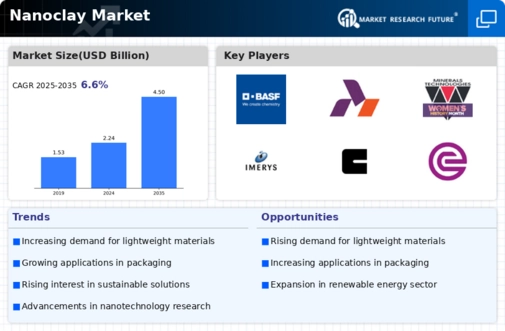Market Trends and Projections
Advancements in Nanotechnology
Technological advancements in nanotechnology significantly influence the Global Nanoclay Market Industry. Innovations in processing techniques and material synthesis enhance the properties of nanoclay, making it more appealing for various applications. For instance, improved dispersion methods lead to better performance in polymers and coatings. As industries adopt these advancements, the market is likely to see a compound annual growth rate of 6.54% from 2025 to 2035. This growth reflects the increasing integration of nanoclay in high-performance materials, thereby expanding its application scope.
Emerging Markets and Economic Growth
Emerging markets play a crucial role in the expansion of the Global Nanoclay Market Industry. Countries in Asia-Pacific and Latin America are experiencing rapid industrialization, leading to increased demand for advanced materials. As these economies grow, the need for lightweight, durable, and cost-effective solutions becomes paramount. Nanoclay, with its unique properties, is well-positioned to meet these demands. The anticipated growth in these regions could contribute significantly to the overall market expansion, aligning with the projected CAGR of 6.54% from 2025 to 2035.
Rising Demand for Lightweight Materials
The Global Nanoclay Market Industry experiences a surge in demand for lightweight materials across various sectors, including automotive and aerospace. Manufacturers increasingly seek alternatives to traditional materials that can enhance performance while reducing weight. Nanoclay, known for its exceptional strength-to-weight ratio, emerges as a preferred choice. In 2024, the market is projected to reach 2.24 USD Billion, driven by the automotive industry's shift towards fuel-efficient vehicles. This trend is expected to continue, with the market potentially reaching 4.5 USD Billion by 2035, indicating a robust growth trajectory.
Environmental Regulations and Sustainability
The Global Nanoclay Market Industry is positively impacted by stringent environmental regulations promoting sustainable materials. As governments worldwide enforce policies aimed at reducing carbon footprints, industries are compelled to adopt eco-friendly alternatives. Nanoclay, being a natural mineral, offers a sustainable solution for various applications, including packaging and construction. Its ability to enhance the mechanical properties of materials while being environmentally benign positions it favorably in the market. This shift towards sustainability is expected to drive growth, as companies seek to comply with regulations while meeting consumer demand for greener products.
Growing Applications in the Packaging Sector
The packaging sector represents a significant growth area for the Global Nanoclay Market Industry. With increasing consumer awareness regarding product safety and environmental impact, manufacturers are turning to nanoclay-enhanced materials that provide superior barrier properties. These materials help in extending shelf life and reducing waste. As a result, the market is anticipated to witness substantial growth, with projections indicating an increase from 2.24 USD Billion in 2024 to 4.5 USD Billion by 2035. This trend underscores the versatility of nanoclay in addressing contemporary packaging challenges.









